Biodesulfurization of Consortia Immobilized on Oil Palm Frond Biochar in Biotrickling Filters under Anoxic Conditions
Abstract
1. Introduction
2. Materials and Methods
2.1. Consortia Sources and Immobilization on OPF Biochar
2.2. Biotrickling Filter (BTF) Setup and Operation
2.3. Next-Generation Sequencing (NGS) of Microbial Community
2.4. Analytical Methods
3. Results
3.1. Effect of Inlet H2S Concentration
3.2. Microbial Community Analysis
3.3. Effect of the N/S Ratio
3.4. Elimination Capacity of the BTFs
3.5. Effect of DO in the Recirculating Liquid on the Performance of the Anoxic BTF System
4. Discussion
5. Conclusions
Author Contributions
Funding
Institutional Review Board Statement
Informed Consent Statement
Data Availability Statement
Conflicts of Interest
References
- Das, J.; Ravishankar, H.; Lens, P.N.L. Biological biogas purification: Recent developments, challenges and future prospects. J. Environ. Manag. 2022, 304, 114198. [Google Scholar] [CrossRef]
- Dumont, E. H2S removal from biogas using bioreactors: A review. Int. J. Energy Environ. Eng. 2015, 6, 479–498. [Google Scholar]
- Pudi, A.; Rezaei, M.; Signorini, V.; Andersson, M.P.; Baschetti, M.G.; Mansouri, S.S. Hydrogen sulfide capture and removal technologies: A comprehensive review of recent developments and emerging trends. Sep. Purif. Technol. 2022, 298, 121448. [Google Scholar] [CrossRef]
- Vu, H.P.; Nguyen, L.N.; Wang, Q.; Ngo, H.H.; Liu, Q.; Zhang, X.; Nghiem, L.D. Hydrogen sulphide management in anaerobic digestion: A critical review on input control, process regulation, and post-treatment. Bioresour. Technol. 2022, 346, 126634. [Google Scholar] [CrossRef] [PubMed]
- Pokorna, S.; Zabranska, J. Sulfur-oxidizing bacteria in environmental technology. Biotechnol. Adv. 2015, 33, 1246–1259. [Google Scholar] [CrossRef] [PubMed]
- Feng, S.; Jiang, Z.; Chen, Y.; Gong, L.; Tong, Y.; Zhang, H.; Huang, X.; Yang, H. Simultaneous denitrification and desulfurization-S0 recovery of wastewater in trickling filters by bioaugmentation intervention based on avoiding collapse critical points. J. Environ. Manag. 2021, 292, 112834. [Google Scholar] [CrossRef]
- Ren, B.; Lyczko, N.; Zhao, Y.; Nzihou, A. Simultaneous hydrogen sulfide removal and wastewater purification in a novel alum sludge-based odor-gas aerated biofilter. Chem. Eng. J. 2021, 419, 129558. [Google Scholar] [CrossRef]
- López, M.E.; Rene, E.R.; Veiga, M.C.; Kennes, C.K. Biogas technologies and cleaning techniques. In Environmental Chemistry for Sustainable World: Remediation of Air and Water Pollution; Lichtfouse, E., Schwarzbauer, J., Robert, D., Eds.; Springer: Dordrecht, The Netherlands, 2012; Volume 2, pp. 347–377. [Google Scholar]
- Fernández, M.; Ramírez, M.; Gómez, J.M.; Cantero, D. Biogas biodesulfurization in an anoxic biotrickling filter packed with open-pore polyurethane foam. J. Hazard. Mater. 2014, 264, 529–535. [Google Scholar] [CrossRef]
- López, L.R.; Brito, J.; Mora, M.; Almenglo, F.; Baeza, J.A.; Ramírez, M.; Lafuente, J.; Cantero, D.; Gabriel, D. Feedforward control application in aerobic and anoxic biotrickling filters for H2S removal from biogas. J. Chem. Technol. Biotechnol. 2018, 93, 2307–2315. [Google Scholar] [CrossRef]
- Almenglo, F.; González-Cortés, J.J.; Ramírez, M.; Cantero, D. Recent advances in biological technologies for anoxic biogas desulfurization. Chemosphere 2023, 321, 138084. [Google Scholar] [CrossRef]
- Khanongnuch, R.; Di Capua, F.; Lakaniemi, A.M.; Rene, E.R.; Lens, P.N.L. H2S removal and microbial community composition in an anoxic biotrickling filter under autotrophic and mixotrophic conditions. J. Hazard. Mater. 2019, 367, 397–406. [Google Scholar] [CrossRef]
- Jahanbani Veshareh, M.; Nick, H.M. A sulfur and nitrogen cycle informed model to simulate nitrate treatment of reservoir souring. Sci. Rep. 2019, 9, 7546. [Google Scholar] [CrossRef]
- Cano, P.I.; Almenglo, F.; Ramírez, R.; Cantero, D. Integration of a nitrification bioreactor and an anoxic biotrickling filter for simultaneous ammonium-rich water treatment and biogas desulfurization. Chemosphere 2021, 284, 131358. [Google Scholar] [CrossRef]
- Das, J.; Rene, E.R.; Dupont, C.; Dufourny, A.; Blin, J.; van Hullebusch, E.D. Performance of a compost and biochar packed biofilter for gas-phase hydrogen sulfide removal. Bioresour. Technol. 2019, 273, 581–591. [Google Scholar] [CrossRef] [PubMed]
- Zhao, W.; Yang, H.; He, S.; Zhao, Q.; Wei, L. A review of biochar in anaerobic digestion to improve biogas production: Performances, mechanisms and economic assessments. Bioresour. Technol. 2021, 341, 125797. [Google Scholar] [CrossRef] [PubMed]
- Kanjanarong, J.; Giri, B.S.; Jaisi, D.P.; Oliveira, F.R.; Boonsawang, P.; Chaiprapat, S.; Singh, R.S.; Balakrishna, A.; Khanal, S.K. Removal of hydrogen sulfide generated during anaerobic treatment of sulfate-laden wastewater using biochar: Evaluation of efficiency and mechanisms. Bioresour. Technol. 2017, 234, 115–121. [Google Scholar] [CrossRef] [PubMed]
- Oliveira, F.R.; Surendra, K.C.; Jaisi, D.P.; Lu, H.; Unal-Tosun, G.; Sung, S.; Khanal, S.K. Alleviating sulfide toxicity using biochar during anaerobic treatment of sulfate-laden wastewater. Bioresour. Technol. 2020, 301, 122711. [Google Scholar] [CrossRef]
- Oliveira, F.R.; Patel, A.K.; Jaisi, D.P.; Adhikari, S.; Lu, H.; Khanal, S.K. Environmental application of biochar: Current status and perspectives. Bioresour. Technol. 2017, 246, 110–122. [Google Scholar] [CrossRef]
- Xu, X.; Cao, X.; Zhao, L.; Sun, T. Comparison of sewage sludge- and pig manure-derived biochars for hydrogen sulfide removal. Chemosphere 2014, 111, 296–303. [Google Scholar] [CrossRef]
- Lawal, A.A.; Hassan, M.A.; Zakaria, M.R.; Yusoff, M.Z.M.; Norrrahim, M.N.F.; Mokhtar, M.N.; Shirai, Y. Effect of oil palm biomass cellulosic content on nanopore structure and adsorption capacity of biochar. Bioresour. Technol. 2021, 332, 125070. [Google Scholar] [CrossRef]
- Som, A.M.; Wang, Z.; Al-Tabbaa, A. Palm frond biochar production and characterization. Earth Environ. Sci. Trans. R. Soc. Edinb. 2012, 103, 39–50. [Google Scholar]
- Sutarut, P.; Cheirsilp, B.; Boonsawang, P. The potential of oil palm frond biochar for the adsorption of residual pollutants from real latex industrial wastewater. Int. J. Environ. Res. 2023, 17, 16. [Google Scholar] [CrossRef]
- American Public Health Association; American Water Works Association; Water Environment Federation. Standard Method of the Examination of the Water and Wastewater, 21st ed.; part 4000; APHA Press: Washington, DC, USA, 2005. [Google Scholar]
- Kumdhitiahutsawakul, L.; Jirachaisakdeacha, D.; Kantha, U.; Pholchan, P.; Sattayawat, P.; Chitov, T.; Tragoolpua, Y.; Bovonsombut, S. Removal of hydrogen sulfide from swine-waste biogas on a pilot scale using immobilized Paracoccus versutus CM1. Microorganisms 2022, 10, 2148. [Google Scholar] [CrossRef] [PubMed]
- Wang, X.; Zhang, Y.; Zhang, T.; Zhou, J. Effect of dissolved oxygen on elemental sulfur generation in sulfide and nitrate removal process: Characterization, pathway, and microbial community analysis. Appl. Microbiol. Biotechnol. 2016, 100, 2895–2905. [Google Scholar] [CrossRef] [PubMed]
- González-Cortés, J.J.; Quijano, G.; Ramírez, M.; Cantero, D. Methane concentration and bacterial communities’ dynamics during the anoxic desulfurization of landfill biogas under diverse nitrate sources and hydraulic residence times. J. Environ. Chem. Eng. 2023, 11, 109285. [Google Scholar] [CrossRef]
- Brito, J.; Valle, A.; Almenglo, F.; Ramírez, M.; Cantero, D. Characterization ofeubacterial communities by Denaturing Gradient Gel Electrophoresis (DGGE) and Next Generation Sequencing (NGS) in a desulfurization biotrickling filter using progressive changes of nitrate and nitrite as final electron acceptors. New Biotechnol. 2020, 57, 67–75. [Google Scholar] [CrossRef]
- Huang, C.; Li, Z.-L.; Chen, F.; Liu, Q.; Zhao, Y.K.; Zhou, J.Z.; Wang, A.J. Microbial community structure and function in response to the shift of sulfide/nitrate loading ratio during the denitrifying sulfide removal process. Bioresour. Technol. 2015, 197, 227–234. [Google Scholar] [CrossRef] [PubMed]
- Yan, C.; Huang, J.; Wang, Y.; Lin, X.; Cao, C.; Qian, X. Assessment on the treatment of nitrogen contaminant by constructed wetland exposed to different concentrations of graphene oxide. J. Clean Prod. 2022, 338, 130567. [Google Scholar] [CrossRef]
- Das, J.; Nolan, S.; Lens, P.N.L. Simultaneous removal of H2S and NH3 from raw biogas in hollow fibre membrane bioreactors. Environ. Technol. Innov. 2022, 28, 102777. [Google Scholar] [CrossRef]
- Bai, Y.; Wang, S.; Zhussupbekova, A.; Shvets, I.V.; Lee, P.H.; Zhan, X. High-rate iron sulfide and sulfur-coupled autotrophic denitrification system: Nutrients removal performance and microbial characterization. Water Res. 2023, 231, 1196198. [Google Scholar] [CrossRef] [PubMed]
- Huang, S.; Yu, D.; Chen, G.; Wang, Y.; Tang, P.; Liu, C.; Tian, Y.; Zhang, M. Realization of nitrite accumulation in a sulfide-driven autotrophic denitrification process: Simultaneous nitrate and sulfur removal. Chemosphere 2021, 278, 130413. [Google Scholar] [CrossRef]
- Haosagul, S.; Prommeenate, P.; Hobbs, G.; Pisutpaisal, N. Sulfide-oxidizing bacteria community in full-scale bioscrubber treating H2S in biogas from swine anaerobic digester. Renew. Energy 2020, 150, 973–980. [Google Scholar] [CrossRef]
- Jaber, M.B.; Couvert, A.; Amrane, A.; Cloirec, P.L.; Dumont, E. Hydrogen sulfide removal from a biogas mimic by biofiltration under anoxic conditions. J. Environ. Chem. Eng. 2017, 5, 5617–5623. [Google Scholar] [CrossRef]
- Li, X.; Jiang, X.; Zhou, Q.; Jiang, W. Effect of S/N ratio on the removal of hydrogen sulfide from biogas in anoxic bioreactors. Appl. Biochem. Biotechnol. 2016, 180, 930–944. [Google Scholar] [CrossRef] [PubMed]
- Zhang, R.C.; Chen, C.; Wang, W.; Shao, B.; Xu, X.J.; Zhou, X.; Lee, D.J.; Ren, N.Q. The stimulating metabolic mechanisms response to sulfide and oxygen in typical heterotrophic sulfide-oxidizing nitrate-reducing bacteria Pseudomonas C27. Bioresour. Technol. 2020, 309, 123451. [Google Scholar] [CrossRef] [PubMed]
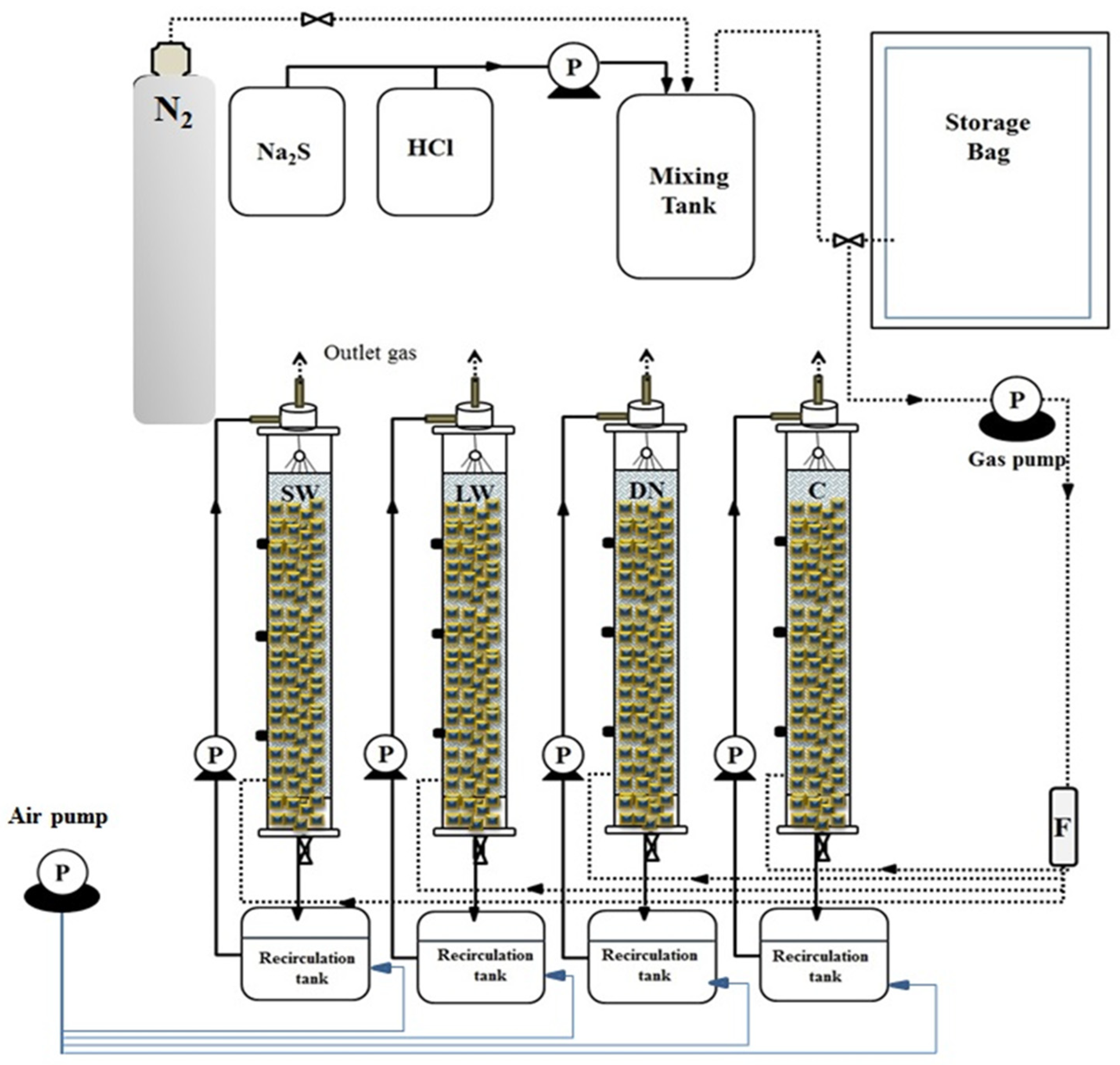
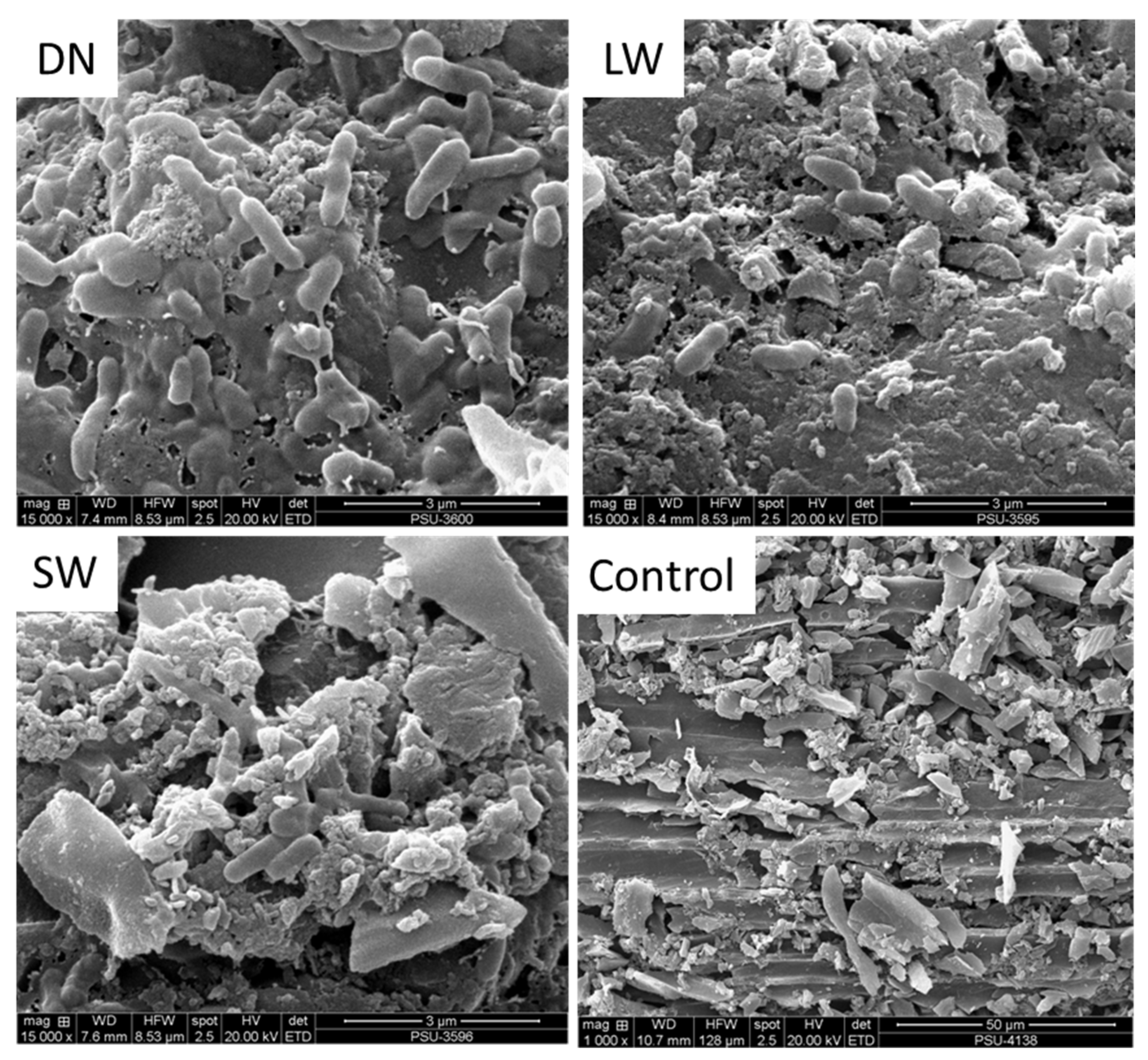
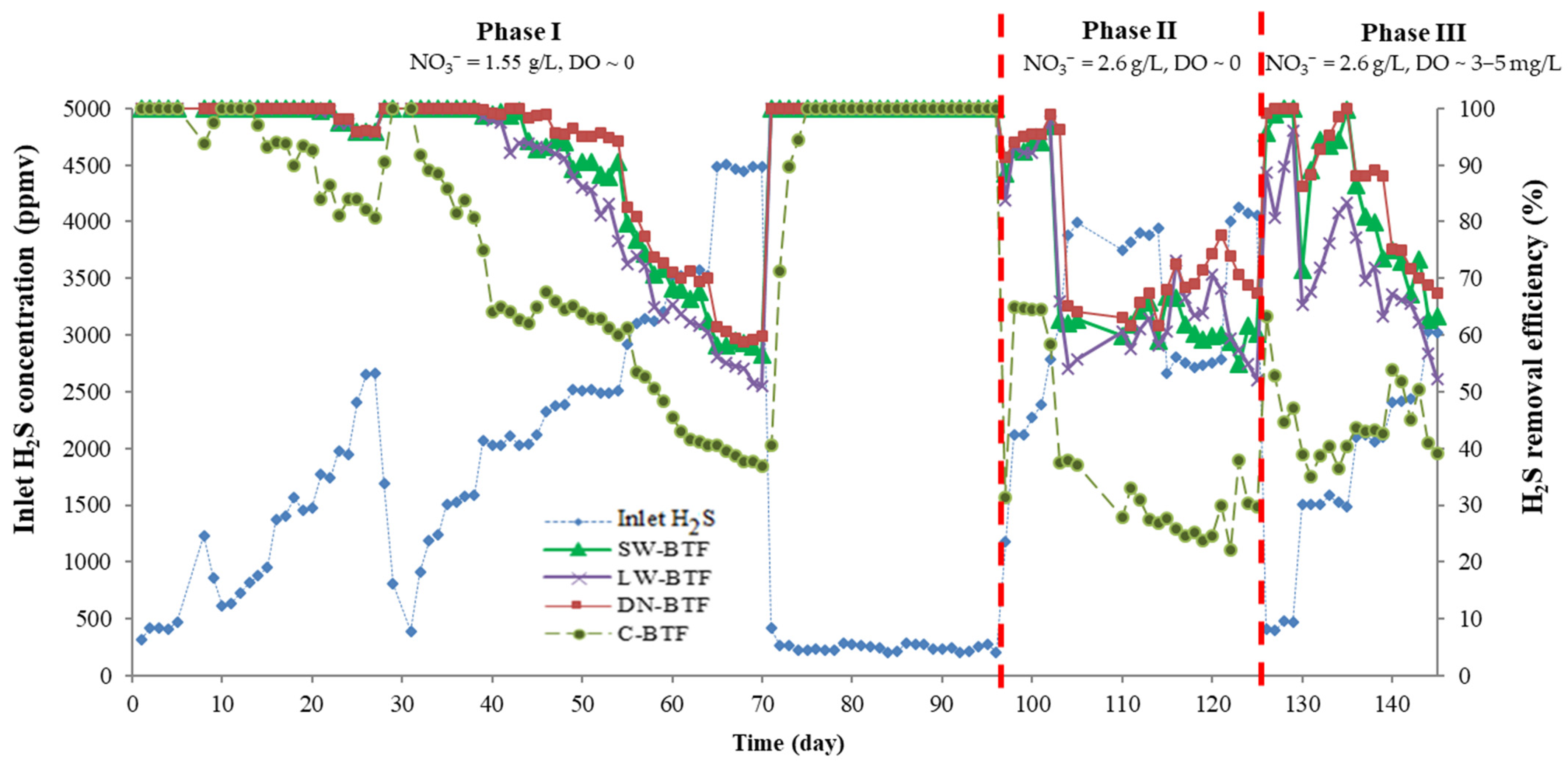
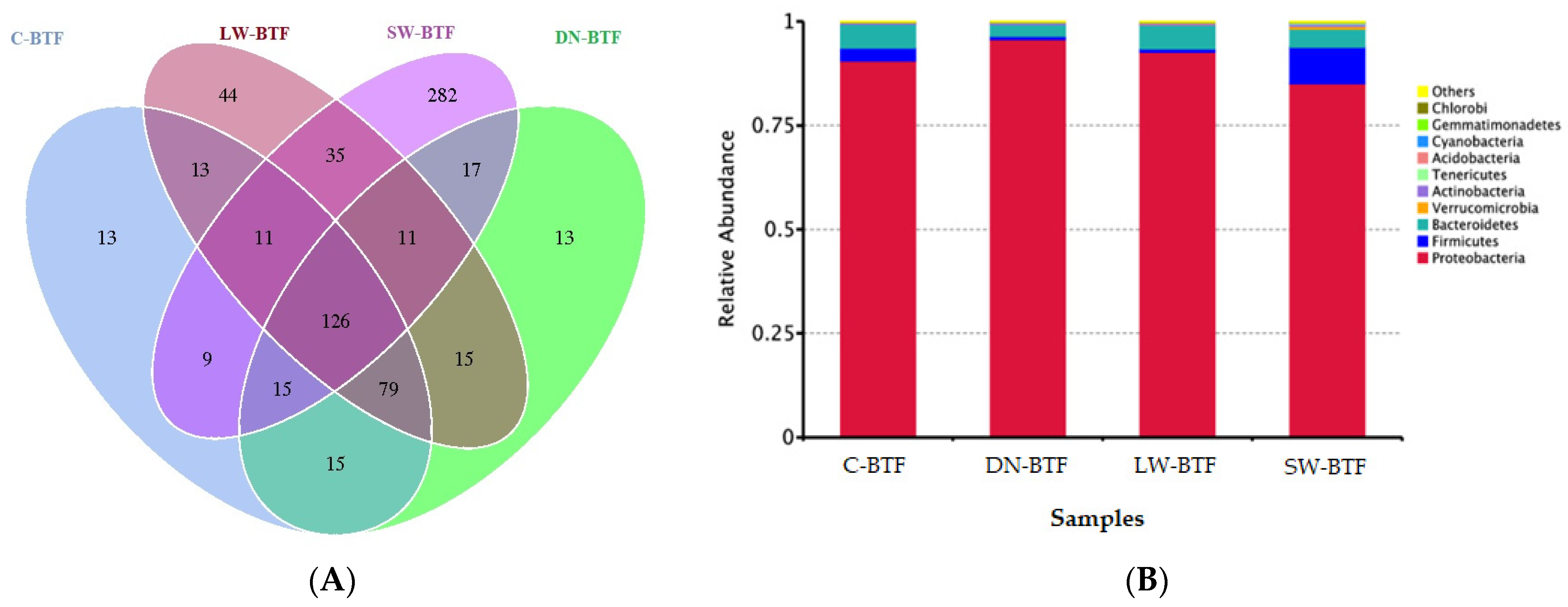
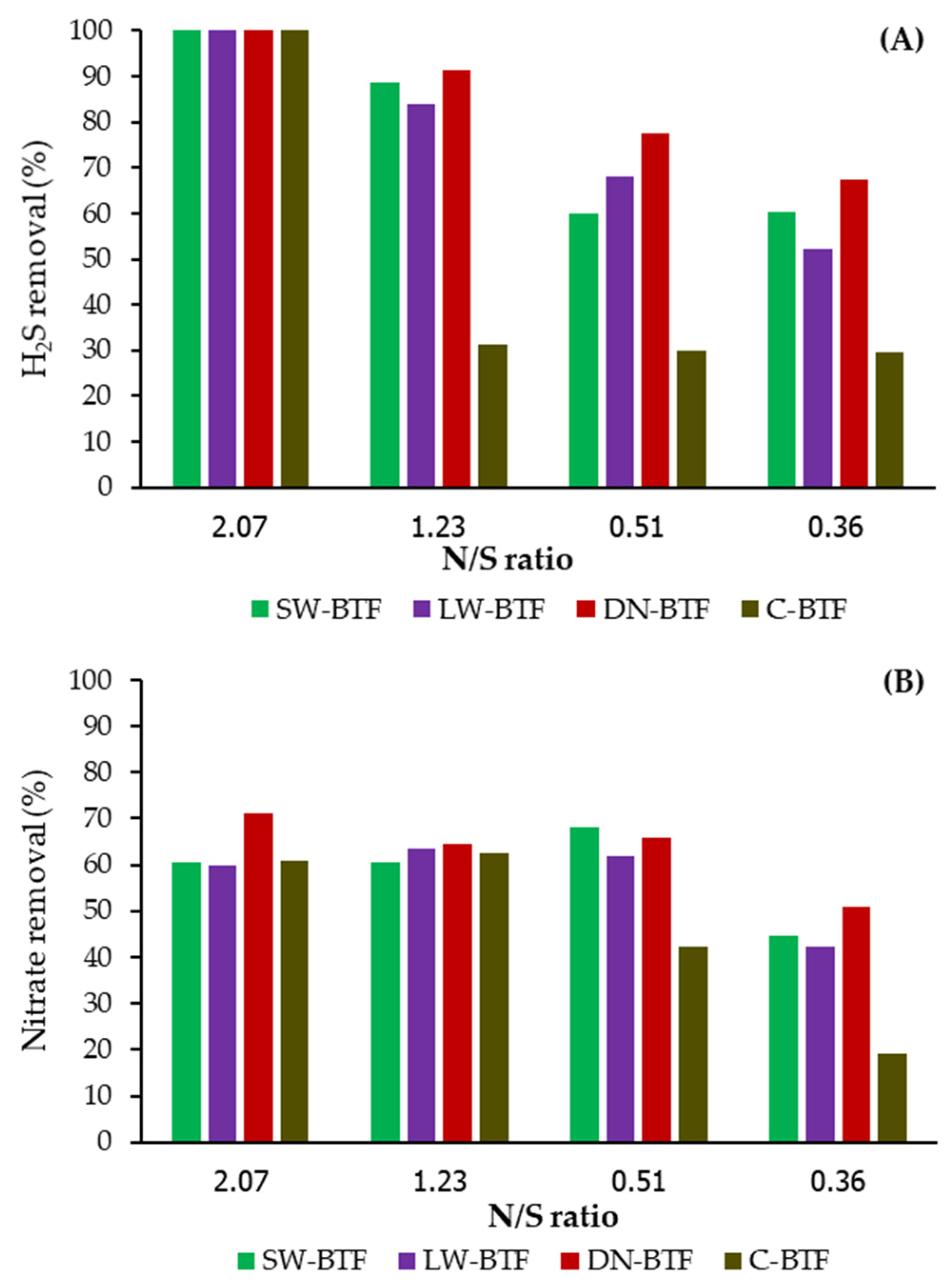
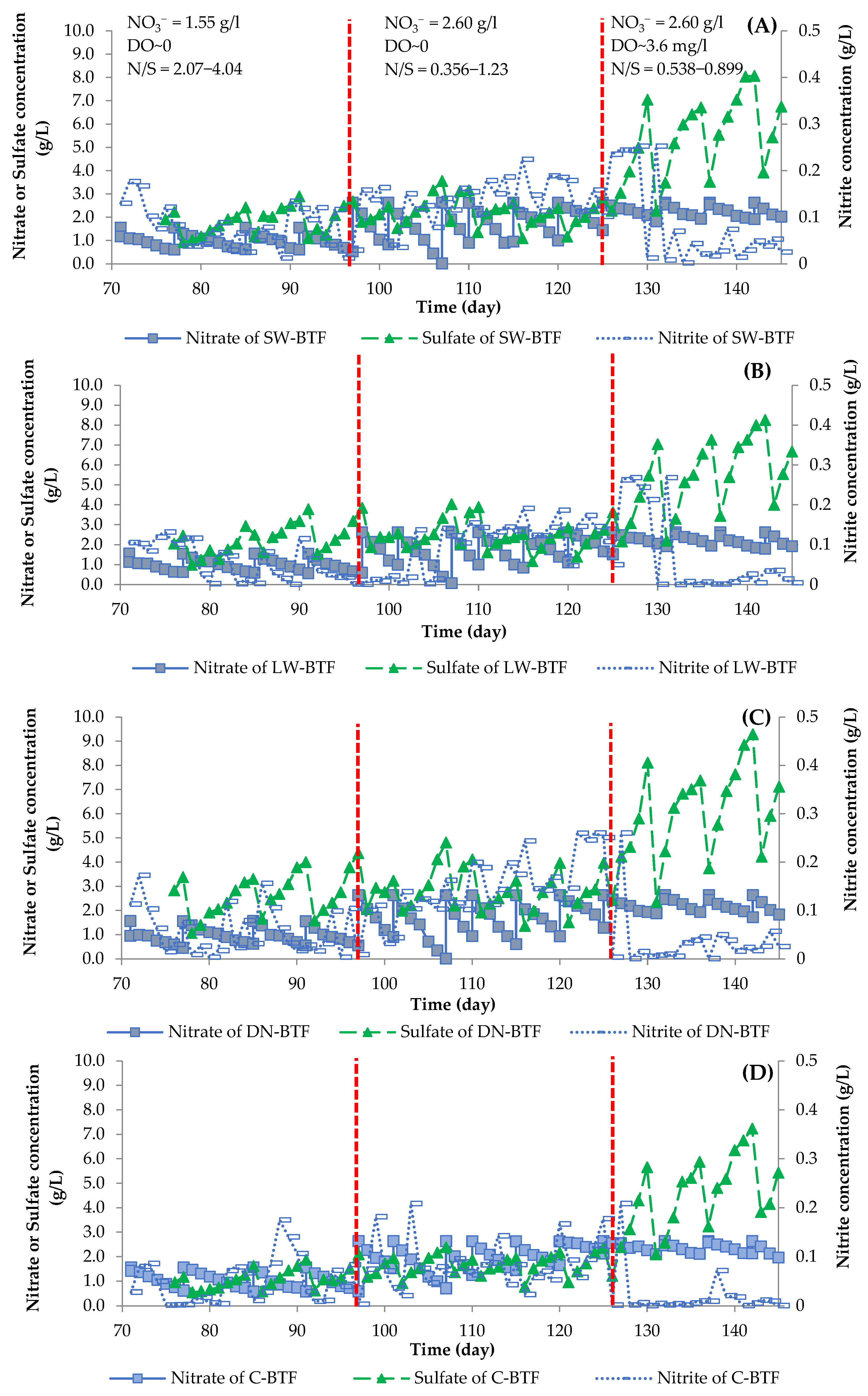
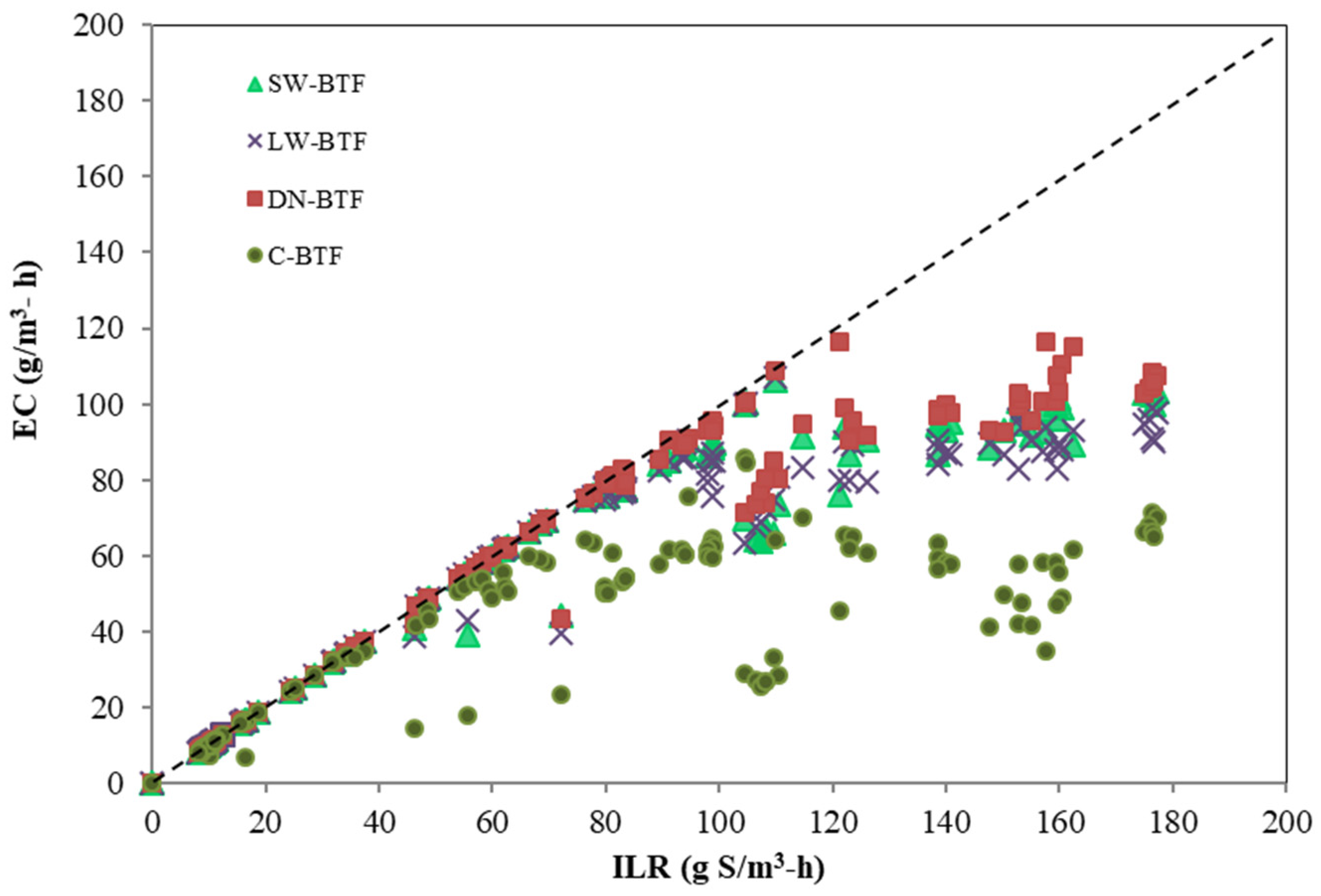
| Parameter | SW | LW | DN |
|---|---|---|---|
| pH | 7.03 ± 0.01 | 7.49 ± 0.5 | 7.91 ± 0.03 |
| Total solid (mg/L) | 17,172 ± 34.2 | 5348 ± 9.29 | 518.7 ± 8.37 |
| Nitrate (mg/L) | 0.47 ± 0 | <0.20 | 0.66 ± 0 |
| Sulfide (mg/L) | 1180 ± 5.01 | 312 ± 2.52 | 30.0 ± 1.53 |
| Sulfate (mg/L) | 37 ± 1.0 | 280 ± 0 | 29 ± 0 |
| Total organic carbon (mg/L) | 11,320 ± 113 | 791 ± 50.7 | 107 ± 7.35 |
| Total Carbon (mg/L) | 2870 ± 113 | 824 ± 9.33 | 257 ± 3.07 |
| Total phosphorus (mg/L) | 80.7 ± 0.682 | 50.4 ± 0.397 | 53.1 ± 0.010 |
| Parameter | Phase | ||
|---|---|---|---|
| I | II | III | |
| Day | 1–96 | 97–125 | 126–145 |
| Initial H2S concentration (CI) (ppmv) | 207.8–4509 | 207.8–4131 | 402.8–3112 |
| Inlet loading rate (ILR) (gS/m3-h) | 8.17–177.3 | 8.17–162.5 | 12.7–97.9 |
| The gas flow rate (m3/h) | 0.06 | 0.06 | 0.48 |
| EBRT (s) | 139 | 139 | 174 |
| DO (mg/L) | ~0 | ~0 | 3.60 ± 0.41 |
| Initial NO3− concentration in the recirculating media (g/L) | 1.55 ± 2.1 | 2.6 ± 1.2 | 2.6 ± 1.2 |
| Recirculation flow rate (L/h) | 7.7 | 7.7 | 7.7 |
| pH of the initial nutrient solution | 6.25–7.25 | 6.5–7.25 | 6.5–7.25 |
| pH in the recirculating systems | No control | No control | 6.5–7.25 |
| Microbial Genera | Taxa Relative Abundance % | |||
|---|---|---|---|---|
| C-BTF | DN-BTF | LW-BTF | SW-BTF | |
| Proteiniphilum | 4.37 | 1.18 | 2.66 | 0.23 |
| Acinetobacter | 34.8 | 1.46 | 2.95 | 0.80 |
| Arenimonas | 6.10 | 29.3 | 17.3 | 13.8 |
| Castellaniella | 5.92 | 26.2 | 32.9 | 16.1 |
| Pseudomonas | 20.4 | 1.17 | 2.08 | 1.45 |
| Paracoccus | 4.42 | 0.35 | 1.11 | 0.14 |
| Enterobacter | 1.87 | 0.60 | 0.25 | 5.89 |
| Achromobacter | 1.73 | 0.16 | 0.15 | 0.10 |
| Ottowia | 0.36 | 9.36 | 2.53 | 4.77 |
| Thauera | 0.07 | 0.52 | 0.06 | 0.06 |
| Zoogloea | 0.60 | 1.05 | 0.36 | 0.98 |
| Alicycliphilus | 1.12 | 5.43 | 6.33 | 7.21 |
| Rhodanobacter | 1.00 | 5.28 | 10.5 | 20.4 |
| Thiobacillus | 0.92 | 4.04 | 1.24 | 1.98 |
| Aquamicrobium | 1.38 | 1.73 | 2.57 | 1.13 |
| Sphingopyxis | 1.16 | 0.63 | 1.98 | 0.17 |
Disclaimer/Publisher’s Note: The statements, opinions and data contained in all publications are solely those of the individual author(s) and contributor(s) and not of MDPI and/or the editor(s). MDPI and/or the editor(s) disclaim responsibility for any injury to people or property resulting from any ideas, methods, instructions or products referred to in the content. |
© 2023 by the authors. Licensee MDPI, Basel, Switzerland. This article is an open access article distributed under the terms and conditions of the Creative Commons Attribution (CC BY) license (https://creativecommons.org/licenses/by/4.0/).
Share and Cite
Sutarut, P.; Cheirsilp, B.; Boonsawang, P. Biodesulfurization of Consortia Immobilized on Oil Palm Frond Biochar in Biotrickling Filters under Anoxic Conditions. Fermentation 2023, 9, 664. https://doi.org/10.3390/fermentation9070664
Sutarut P, Cheirsilp B, Boonsawang P. Biodesulfurization of Consortia Immobilized on Oil Palm Frond Biochar in Biotrickling Filters under Anoxic Conditions. Fermentation. 2023; 9(7):664. https://doi.org/10.3390/fermentation9070664
Chicago/Turabian StyleSutarut, Pajongsuk, Benjamas Cheirsilp, and Piyarat Boonsawang. 2023. "Biodesulfurization of Consortia Immobilized on Oil Palm Frond Biochar in Biotrickling Filters under Anoxic Conditions" Fermentation 9, no. 7: 664. https://doi.org/10.3390/fermentation9070664
APA StyleSutarut, P., Cheirsilp, B., & Boonsawang, P. (2023). Biodesulfurization of Consortia Immobilized on Oil Palm Frond Biochar in Biotrickling Filters under Anoxic Conditions. Fermentation, 9(7), 664. https://doi.org/10.3390/fermentation9070664






